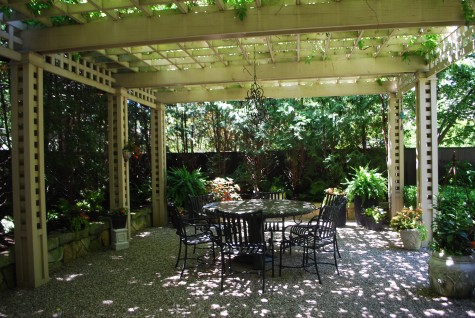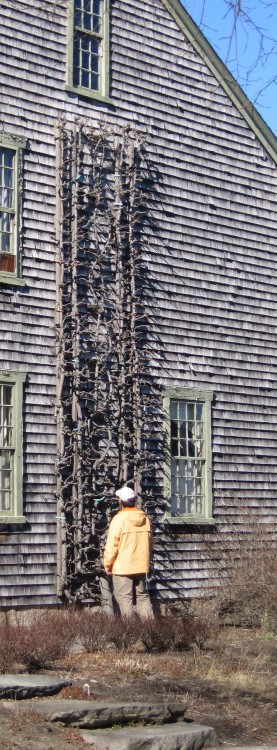 Would not the silhouette of this tree, trained and grown parallel to a wall, get your attention? Even out of leaf, it is striking. You are looking at an espalier- a tree trained to grow in only two dimensions. In the late 1600’s, Fr. Legendre, a monk living in Hanonville France was in charge of his monastery’s garden. His fruit trees were bedevilled by late frosts that killed the fruiting buds. Noticing that the fruit trees planted closest to the monastery walls sustained the least damage, he began planting his fruit trees as close to the walls as possible. As wall space was limited, he began shearing his trees, so as to provide room for all the varieties he wanted to grow. Amazingly, the drastically sheared trees produced heavier yields than unpruned trees in the field. His book, Palmette Legendre, was published shortly before his death in 1684. This book is the earliest known text regarding the science of growing espaliers. These trees, pruned flat, spare, and parallel to a wall, had fewer cultural problems, took up little space, and were beautiful to boot.
Would not the silhouette of this tree, trained and grown parallel to a wall, get your attention? Even out of leaf, it is striking. You are looking at an espalier- a tree trained to grow in only two dimensions. In the late 1600’s, Fr. Legendre, a monk living in Hanonville France was in charge of his monastery’s garden. His fruit trees were bedevilled by late frosts that killed the fruiting buds. Noticing that the fruit trees planted closest to the monastery walls sustained the least damage, he began planting his fruit trees as close to the walls as possible. As wall space was limited, he began shearing his trees, so as to provide room for all the varieties he wanted to grow. Amazingly, the drastically sheared trees produced heavier yields than unpruned trees in the field. His book, Palmette Legendre, was published shortly before his death in 1684. This book is the earliest known text regarding the science of growing espaliers. These trees, pruned flat, spare, and parallel to a wall, had fewer cultural problems, took up little space, and were beautiful to boot.
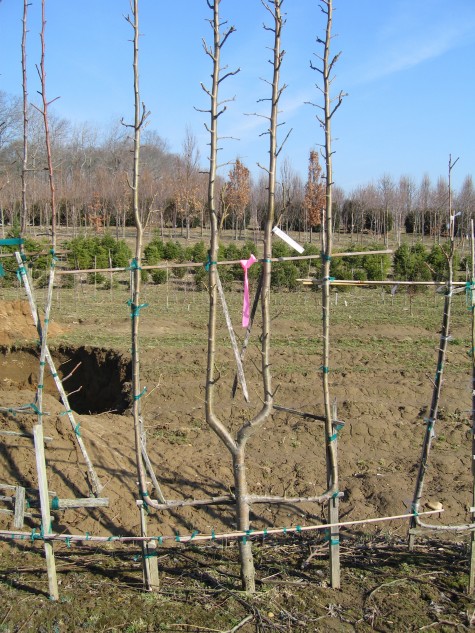 Espaliered fruit trees look like no naturally growing tree . Though no tree expert would advise this kind of planting, pruning and shaping, Father Legendre’s ideas practices enabled ample fruit for everyone living at his monastery. Sometimes the hand of man comes to good end in the environment. This very early spring picture shows an espaliered tree, grown in the candelabra shape. It would be beautiful, grown on a blank wall-never mind the fruit. Training trees to grow in two dimensions became a gardening art form-even for those who had no need to feed many from a very small plot of land.
Espaliered fruit trees look like no naturally growing tree . Though no tree expert would advise this kind of planting, pruning and shaping, Father Legendre’s ideas practices enabled ample fruit for everyone living at his monastery. Sometimes the hand of man comes to good end in the environment. This very early spring picture shows an espaliered tree, grown in the candelabra shape. It would be beautiful, grown on a blank wall-never mind the fruit. Training trees to grow in two dimensions became a gardening art form-even for those who had no need to feed many from a very small plot of land.
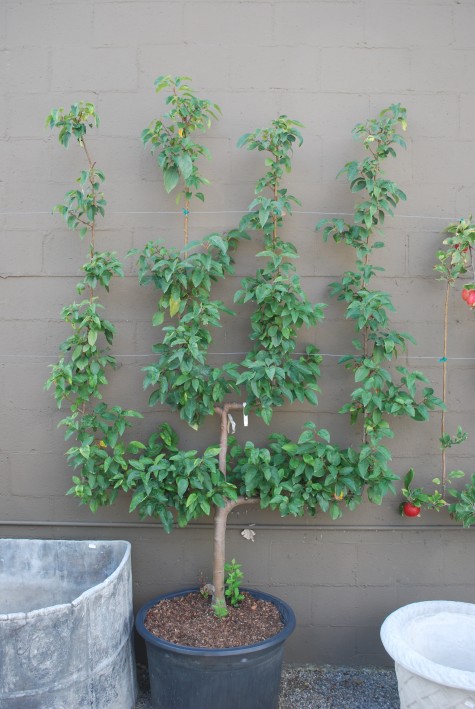 I make a special effort to offer exceptional espaliered trees to my clients. My grower of choice is of French descent, and his espaliers take my breath away. I drive a day’s length to see and review his espaliers. He grows in the traditional way, and only has a few trees to offer for sale every year. He sells no trees that are not at least seven years old; his big trees are much older. He pots his trees, and then sinks the pots in the ground. Note that the trunk of this tree is positioned to the back of its pots-his trees are easy to plant close to a wall.
I make a special effort to offer exceptional espaliered trees to my clients. My grower of choice is of French descent, and his espaliers take my breath away. I drive a day’s length to see and review his espaliers. He grows in the traditional way, and only has a few trees to offer for sale every year. He sells no trees that are not at least seven years old; his big trees are much older. He pots his trees, and then sinks the pots in the ground. Note that the trunk of this tree is positioned to the back of its pots-his trees are easy to plant close to a wall.
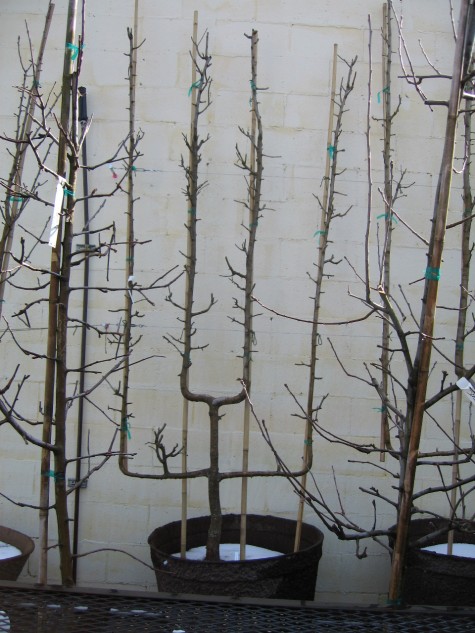 Their winter appearance is architectural. The American landscape is fundamentally based on big spaces; we have eight lane highways and driveways 22 feet wide. This makes this particular dose of French editing all the more refreshing. People who come to my store are invariably interested in their history and forms.
Their winter appearance is architectural. The American landscape is fundamentally based on big spaces; we have eight lane highways and driveways 22 feet wide. This makes this particular dose of French editing all the more refreshing. People who come to my store are invariably interested in their history and forms.
 My grower trains some of his espaliers in a form not existing in the classical literature. This framed heart is entirely his invention; how I love this. It has a distinctly American feeling; he has taken his classical training, and gone beyond.
My grower trains some of his espaliers in a form not existing in the classical literature. This framed heart is entirely his invention; how I love this. It has a distinctly American feeling; he has taken his classical training, and gone beyond.
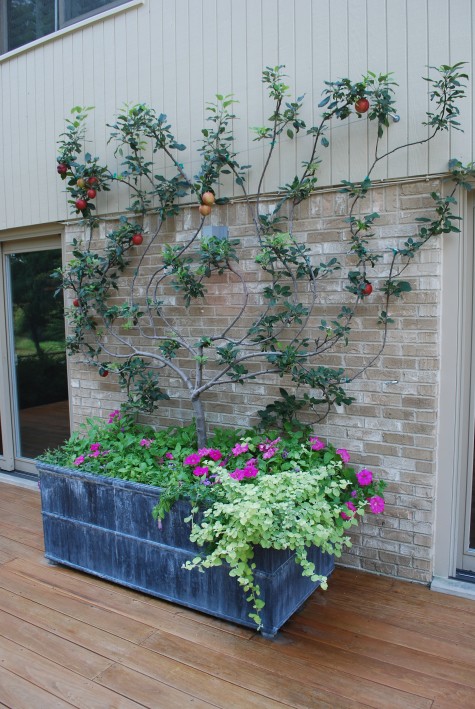 This informal heart espalier enchanted one of my clients. I call it the wild at heart espalier. As she had no room in the ground, we built her a box for her deck, insulated to slow the freeze, and delay the spring thaw; this apple tree is thriving. We heap up the compost after the ground freezes, and we uncover it in the spring; so far, so good.
This informal heart espalier enchanted one of my clients. I call it the wild at heart espalier. As she had no room in the ground, we built her a box for her deck, insulated to slow the freeze, and delay the spring thaw; this apple tree is thriving. We heap up the compost after the ground freezes, and we uncover it in the spring; so far, so good.
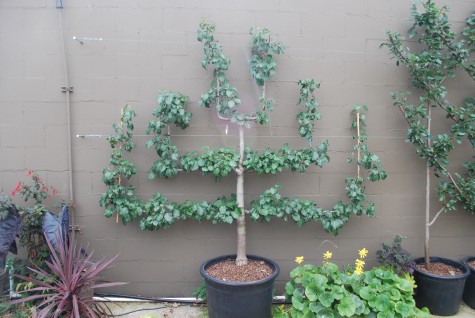 Not all espaliers are fruit trees. The art of training espaliered trees has extended to many trees tolerant of this treatment. This Bradford pear makes a big statement as an espalier. Any lonely wall would be all the happier for this tree planted on it.
Not all espaliers are fruit trees. The art of training espaliered trees has extended to many trees tolerant of this treatment. This Bradford pear makes a big statement as an espalier. Any lonely wall would be all the happier for this tree planted on it.
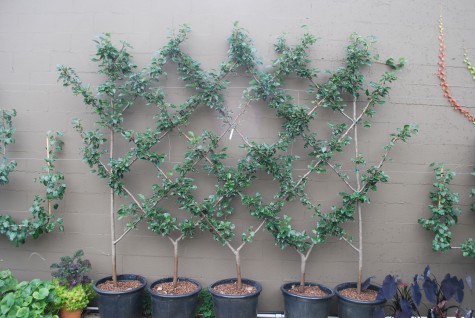 This series of trees is known as a Belgian Fence. You can see that individual trees were topped low to the ground as whips, encouraging branching in both directions. The branches of these trees are trained in a diamond pattern; what a beautiful living ornament for a long wall, or a free standing fence.
This series of trees is known as a Belgian Fence. You can see that individual trees were topped low to the ground as whips, encouraging branching in both directions. The branches of these trees are trained in a diamond pattern; what a beautiful living ornament for a long wall, or a free standing fence.

These shaggy Donald Wyman crabapple espaliers are in need of a trim to reveal their form. But no one could dispute how lustily they are growing. A wall, and an espalier make good companions. Espaliers-of course they are on my list of favorite plants.
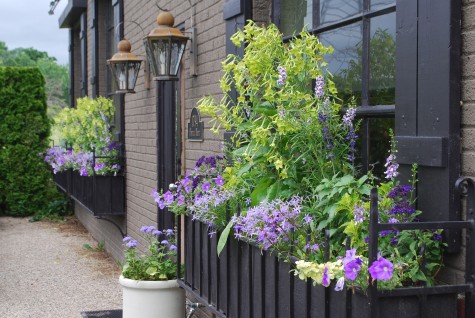
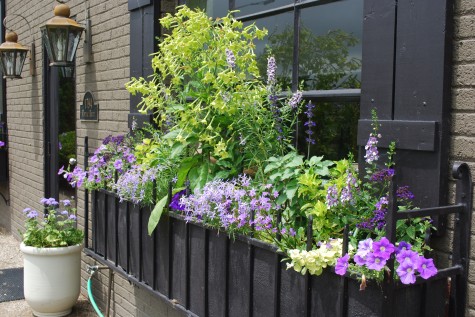 No matter what you fancy in your garden, nothing in it ever stands still. A garden actively grows, or actively sulks, or goes down. Some days I wish I could shift into neutral and coast, but I know better. I also know that as much as I would want to devote a chunk of time to nurturing all my plants, every day, that rarely happens. I have a demanding work life; moving that along every day takes priority. I hedge my bets some with plants that seem to handle the hit and miss nature of my care. Petunias thrive on this treatment; this is one plant that the more I fuss with them, the more they resent it. A trim once in a while is enough. Angelonia does not like cold weather, but it’s not a prima donna either. Once the hot weather comes, they come on strong.
No matter what you fancy in your garden, nothing in it ever stands still. A garden actively grows, or actively sulks, or goes down. Some days I wish I could shift into neutral and coast, but I know better. I also know that as much as I would want to devote a chunk of time to nurturing all my plants, every day, that rarely happens. I have a demanding work life; moving that along every day takes priority. I hedge my bets some with plants that seem to handle the hit and miss nature of my care. Petunias thrive on this treatment; this is one plant that the more I fuss with them, the more they resent it. A trim once in a while is enough. Angelonia does not like cold weather, but it’s not a prima donna either. Once the hot weather comes, they come on strong. 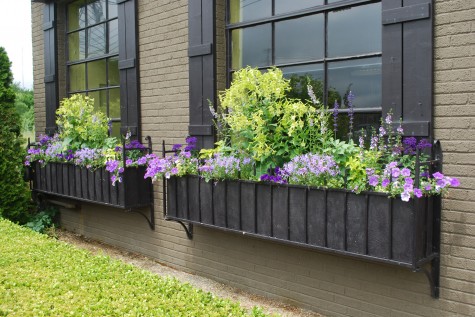 Blue salvia is puny early on; it is a late season annual. In a good year, they handle cooling fall temperatures with aplomb. I knew I would have these late. Planting the blue star-flowered laurentia was risky. Not only am I not so familiar with its habit, it has that look of an early season annual destined to peter out. This I cannot really explain, except to say some plants just look like they won’t do. The heliotrope was stuck in first gear; this plant likes hot weather. But for the moment, the lime nicotiana alata has my attention; the weather was instrumental in making it look perfectly happy. Every year, the weather is perfect for something; I thus follow the National Weather Service three month predictions with a lot of interest in late winter. Occasionally that helps.
Blue salvia is puny early on; it is a late season annual. In a good year, they handle cooling fall temperatures with aplomb. I knew I would have these late. Planting the blue star-flowered laurentia was risky. Not only am I not so familiar with its habit, it has that look of an early season annual destined to peter out. This I cannot really explain, except to say some plants just look like they won’t do. The heliotrope was stuck in first gear; this plant likes hot weather. But for the moment, the lime nicotiana alata has my attention; the weather was instrumental in making it look perfectly happy. Every year, the weather is perfect for something; I thus follow the National Weather Service three month predictions with a lot of interest in late winter. Occasionally that helps. 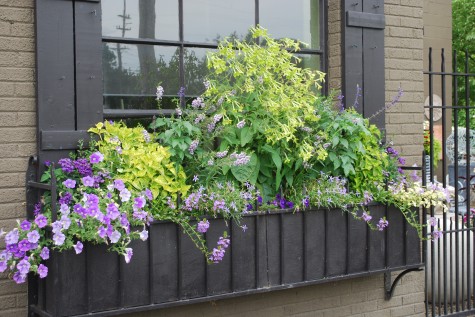 By August first, we were getting an 80 degree day once in a while. You can see the effect on the licorice and heliotrope; too little heat, too late. The flowering on the laurentia is slowing down, as I thought it would. Though the flowering is so- so, the plants are growing fine. The overall shape and the interaction of the group is the success of the box. Cool and dry made for unusually few bugs and no disease .
By August first, we were getting an 80 degree day once in a while. You can see the effect on the licorice and heliotrope; too little heat, too late. The flowering on the laurentia is slowing down, as I thought it would. Though the flowering is so- so, the plants are growing fine. The overall shape and the interaction of the group is the success of the box. Cool and dry made for unusually few bugs and no disease . By early September, my balanced box has gone too tall-bad maintenance on my part. Trimming plants back keeps them stocky, and encourages them to reflower. However, this height is a great look from the street; the flowers are visible over the boxwood.
By early September, my balanced box has gone too tall-bad maintenance on my part. Trimming plants back keeps them stocky, and encourages them to reflower. However, this height is a great look from the street; the flowers are visible over the boxwood.  As I predicted, the laurentia bloomed out, and needs replacing. By September 15, our weather is in transition. I expect night temperatures in the high forties this week yet. However, I am not willing to rip the boxes yet; I hold on to my summer season as long as I can. We are having our warmest daytime temperatures of the season. As there are plenty of plants that thrive in cool night temperatures, I will replace as needed.
As I predicted, the laurentia bloomed out, and needs replacing. By September 15, our weather is in transition. I expect night temperatures in the high forties this week yet. However, I am not willing to rip the boxes yet; I hold on to my summer season as long as I can. We are having our warmest daytime temperatures of the season. As there are plenty of plants that thrive in cool night temperatures, I will replace as needed. 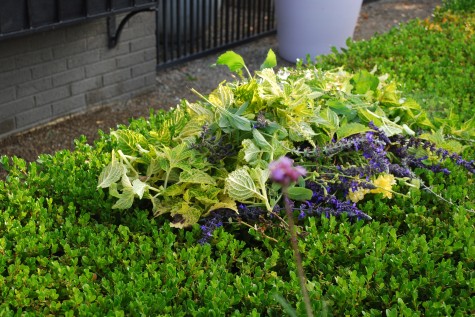 A good haircut and deadheading came first; late is better than never. As long as the warm weather holds, the coleus will respond quickly to the trim. There is no reason to give up what you have looked after all season. There is every good reason to keep what is good, and replace what isn’t.
A good haircut and deadheading came first; late is better than never. As long as the warm weather holds, the coleus will respond quickly to the trim. There is no reason to give up what you have looked after all season. There is every good reason to keep what is good, and replace what isn’t.
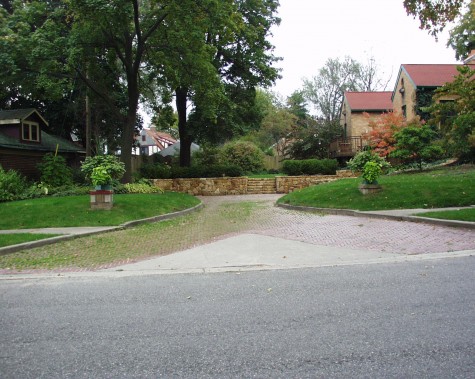 Just yesterday I was telling new clients for whom I had just finished a landscape master plan – pick one small part of your plan and install it. I told them if they got started, and kept at it, a very large piece of work would get done in no time. I did not realize how truly fast the years can go by, until I ran across these pictures of my own yard from 2000. After I moved in my house, I mulched some beds and grassed over others, until I could get to the work. I had just finished the stone wall and stairs; in 2000, my entire landscape effort was put to those walls. It would be years later before I would be able to do the limestone caps.
Just yesterday I was telling new clients for whom I had just finished a landscape master plan – pick one small part of your plan and install it. I told them if they got started, and kept at it, a very large piece of work would get done in no time. I did not realize how truly fast the years can go by, until I ran across these pictures of my own yard from 2000. After I moved in my house, I mulched some beds and grassed over others, until I could get to the work. I had just finished the stone wall and stairs; in 2000, my entire landscape effort was put to those walls. It would be years later before I would be able to do the limestone caps.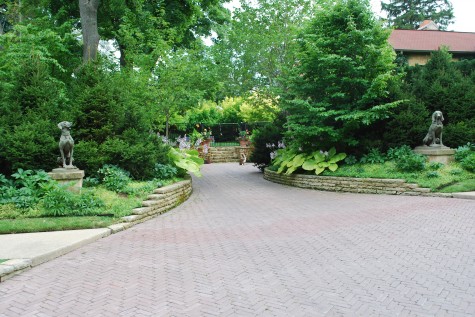
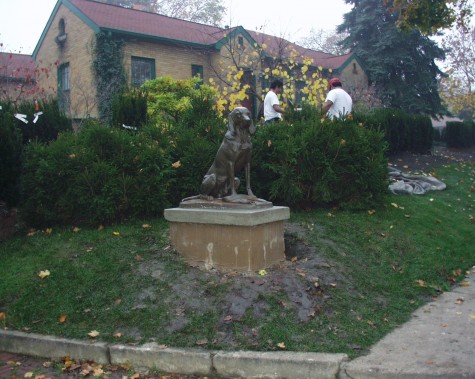 These antique French cast iron dogs guard the drive. The day of installation, my Hicks yews were 36″-42″ tall. Today they are almost nine feet tall. The dwarf picea mucrunulatum behind the dogs have more than doubled in height and width. In lieu of muddy lawn, I have sweet woodriff and hellebores. No doubt my gardening life has gotten better over the past decade.
These antique French cast iron dogs guard the drive. The day of installation, my Hicks yews were 36″-42″ tall. Today they are almost nine feet tall. The dwarf picea mucrunulatum behind the dogs have more than doubled in height and width. In lieu of muddy lawn, I have sweet woodriff and hellebores. No doubt my gardening life has gotten better over the past decade.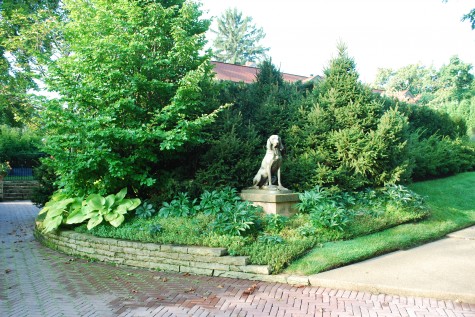 The parrotias, yews, picea, and magnolias screen my house from the street; I have a private home life in an urban neighborhood where the properties are small. The concrete pedestals built for the dogs have aged, and moss is growing on the walls.
The parrotias, yews, picea, and magnolias screen my house from the street; I have a private home life in an urban neighborhood where the properties are small. The concrete pedestals built for the dogs have aged, and moss is growing on the walls. 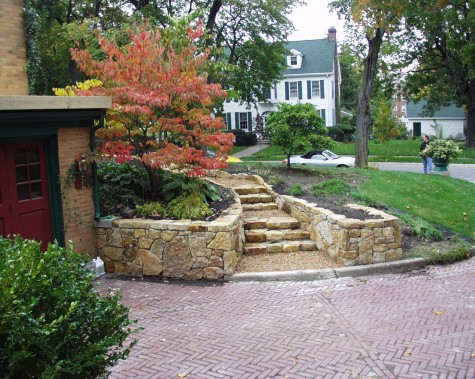 When I was at this stage of the landscape renovation, the thought of a decade of construction and growing never occurred to me. It just would take as long as it would take. The beginning of a project has its charms-the planning, the fussing, and the rethinking. The time has gone by incredibly fast; these low-tech time lapse photographs dramatically detail how much change there has been.
When I was at this stage of the landscape renovation, the thought of a decade of construction and growing never occurred to me. It just would take as long as it would take. The beginning of a project has its charms-the planning, the fussing, and the rethinking. The time has gone by incredibly fast; these low-tech time lapse photographs dramatically detail how much change there has been.  That stone staircase no longer looks so lonely and disassociated from the ground around it. The limestone caps got made for the walls. There is a woodland garden to go with the rustic staircase.
That stone staircase no longer looks so lonely and disassociated from the ground around it. The limestone caps got made for the walls. There is a woodland garden to go with the rustic staircase. I had forgotten the red and green trim that came with the house. The octagonal wood deck would get a stone skirt, and a narrow Romeo and Juliet balcony would be installed above the garage doors. The wood rails would be replaced with iron. My folly would be installed above the back porch.
I had forgotten the red and green trim that came with the house. The octagonal wood deck would get a stone skirt, and a narrow Romeo and Juliet balcony would be installed above the garage doors. The wood rails would be replaced with iron. My folly would be installed above the back porch. 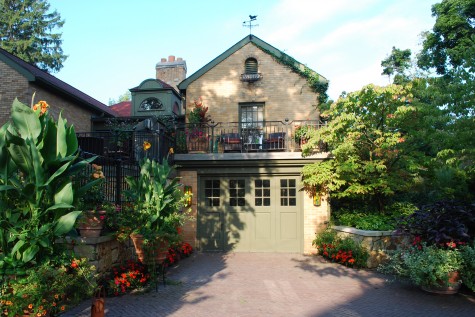
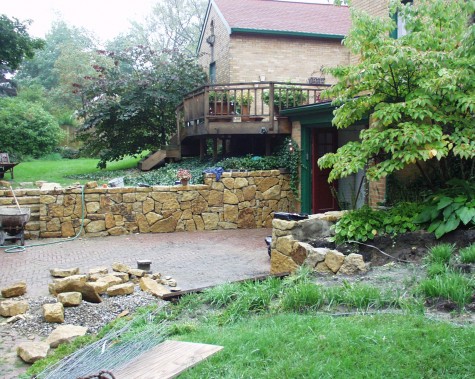 I am so glad to have these old pictures. I had forgotten how awful that deck and stairs looked. Without tearing the entire thing out and starting over, I do think the look of it is greatly improved. No landscape existed per se-I had a collection of plants. I am sure the previous owners liked each plant individually, but there was no thought put to their relationships to each other. My landscape is much more simple, and easy for me to maintain.
I am so glad to have these old pictures. I had forgotten how awful that deck and stairs looked. Without tearing the entire thing out and starting over, I do think the look of it is greatly improved. No landscape existed per se-I had a collection of plants. I am sure the previous owners liked each plant individually, but there was no thought put to their relationships to each other. My landscape is much more simple, and easy for me to maintain.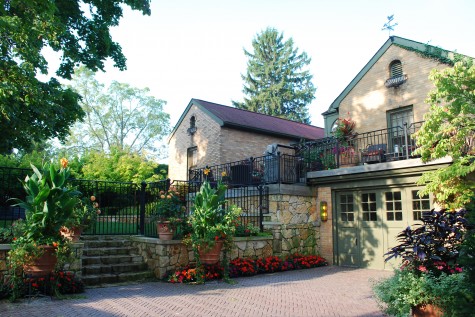
 Yesterday’s essay spoke to the issue of creating privacy in small urban gardens. An addition to this existing home had all but eliminated good access to the rear yard. I took my clients by surprise-suggesting that French doors into the garden from the rear wall of the garage would readily solve that problem. So solve the problem we did.
Yesterday’s essay spoke to the issue of creating privacy in small urban gardens. An addition to this existing home had all but eliminated good access to the rear yard. I took my clients by surprise-suggesting that French doors into the garden from the rear wall of the garage would readily solve that problem. So solve the problem we did. 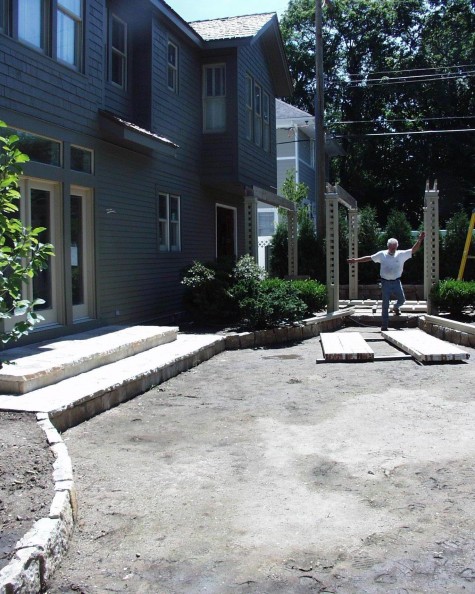 The last issue regarding views was specific to the addition. A master bedroom suite had been built over the garage-complete with views from three windows to neighboring yards. As is would be some time before the perimeter plantings would screen second story windows, a pergola outside the new doors from the garage seemed like a good idea; the roof of the pergola, and its wisteria, would provide the room upstairs with a view.
The last issue regarding views was specific to the addition. A master bedroom suite had been built over the garage-complete with views from three windows to neighboring yards. As is would be some time before the perimeter plantings would screen second story windows, a pergola outside the new doors from the garage seemed like a good idea; the roof of the pergola, and its wisteria, would provide the room upstairs with a view.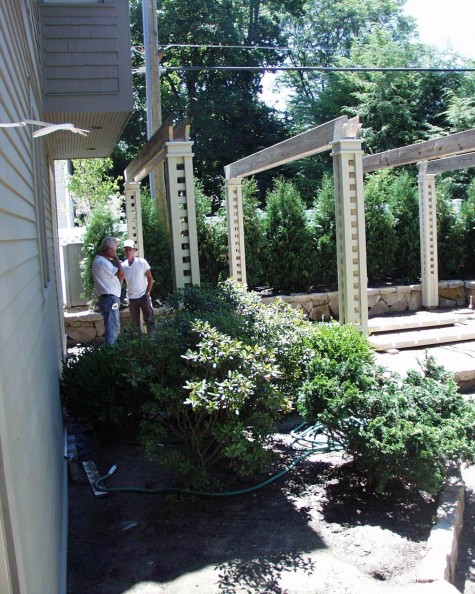
 Based on a grid, the pillars and roof of the pergola have great visual appeal. A decomposed granite terrace provided a hard surface that would work for a soaking tub, a table and chairs for dining or reading. They would decide how to furnish the space, once it was finished.
Based on a grid, the pillars and roof of the pergola have great visual appeal. A decomposed granite terrace provided a hard surface that would work for a soaking tub, a table and chairs for dining or reading. They would decide how to furnish the space, once it was finished. 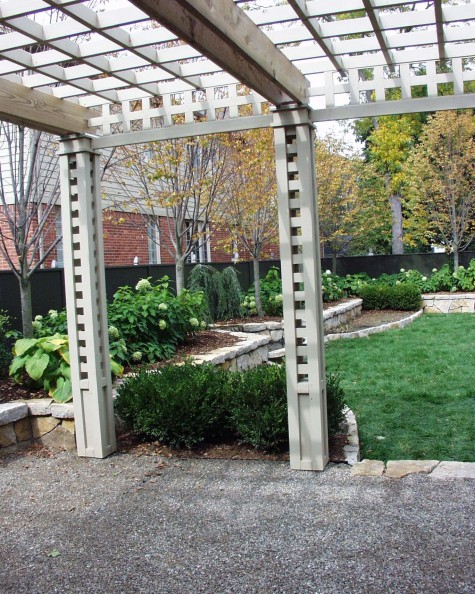
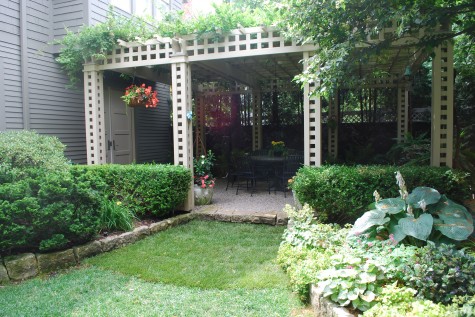 The garden has grown considerably in the past eight years. A wisteria now covers the roof of the pergola; at some point, a good pruning will be in order. Maintaining a dappled shade under its roof makes this spot a fine place to be on a hot sunny summer day. All the plants, from a great specimen of Magnolia “Elizabeth”, to a collection of hostas, are thriving.
The garden has grown considerably in the past eight years. A wisteria now covers the roof of the pergola; at some point, a good pruning will be in order. Maintaining a dappled shade under its roof makes this spot a fine place to be on a hot sunny summer day. All the plants, from a great specimen of Magnolia “Elizabeth”, to a collection of hostas, are thriving.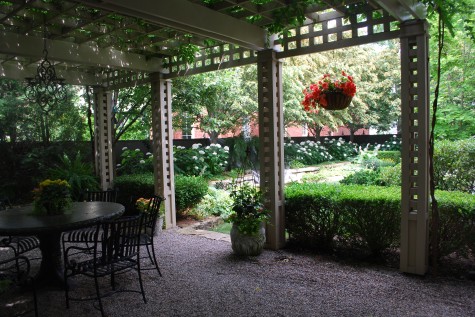 The lindens have grown considerably, and provide a great deal of privacy to the garden. Pots of annuals and furniture warm up and greatly personalize the space. As a guest at a birthday party here this past June, I was so pleased that the landscape provided space for people to sit, talk, and interact. Over fifty people moved from inside to outdoors and back with ease. No one’s eye was directed to or interested in what was next door. Having dinner at this very table, I felt this very small space worked, and worked in a lively way.
The lindens have grown considerably, and provide a great deal of privacy to the garden. Pots of annuals and furniture warm up and greatly personalize the space. As a guest at a birthday party here this past June, I was so pleased that the landscape provided space for people to sit, talk, and interact. Over fifty people moved from inside to outdoors and back with ease. No one’s eye was directed to or interested in what was next door. Having dinner at this very table, I felt this very small space worked, and worked in a lively way.